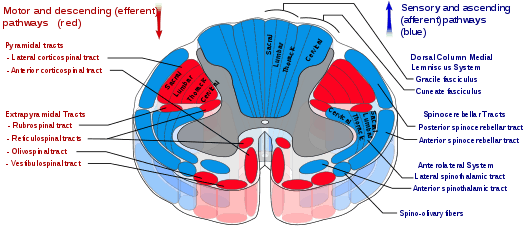Extrapyramidal system
In anatomy, the extrapyramidal system is a part of the motor system network causing involuntary actions.[1] The system is called extrapyramidal to distinguish it from the tracts of the motor cortex that reach their targets by traveling through the pyramids of the medulla. The pyramidal tracts (corticospinal tract and corticobulbar tracts) may directly innervate motor neurons of the spinal cord or brainstem (anterior (ventral) horn cells or certain cranial nerve nuclei), whereas the extrapyramidal system centers on the modulation and regulation (indirect control) of anterior (ventral) horn cells.
| Extrapyramidal system | |
|---|---|
 Medulla spinalis. (Extrapyramidal tracts are labeled as a group in red, at bottom left.) | |
| Details | |
| Identifiers | |
| Latin | Systema extrapyramidale |
| NeuroNames | 2070 |
| Anatomical terms of neuroanatomy | |
Extrapyramidal tracts are chiefly found in the reticular formation of the pons and medulla, and target lower motor neurons in the spinal cord that are involved in reflexes, locomotion, complex movements, and postural control. These tracts are in turn modulated by various parts of the central nervous system, including the nigrostriatal pathway, the basal ganglia, the cerebellum, the vestibular nuclei, and different sensory areas of the cerebral cortex. All of these regulatory components can be considered part of the extrapyramidal system, in that they modulate motor activity without directly innervating motor neurons.
The extrapyramidal tracts include parts of the following:[2]
See also
- List of regions in the human brain
- Extrapyramidal symptoms
- Rabbit syndrome, a rare extrapyramidal side effect
- Reticulospinal tract
- Tectospinal tract
- Vestibulospinal tract
References
- Yuan, Rui; Di, Xin; Taylor, Paul A.; Gohel, Suril; Tsai, Yuan-Hsiung; Biswal, Bharat B. (30 April 2015). "Functional topography of the thalamocortical system in human". Brain Structure and Function. 221 (4): 1971–1984. doi:10.1007/s00429-015-1018-7. PMC 6363530. PMID 25924563.
- Costanzo, Linda S. (30 July 2010). Physiology. LWW. ISBN 978-0781798761.